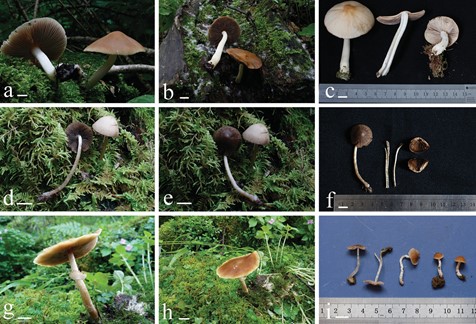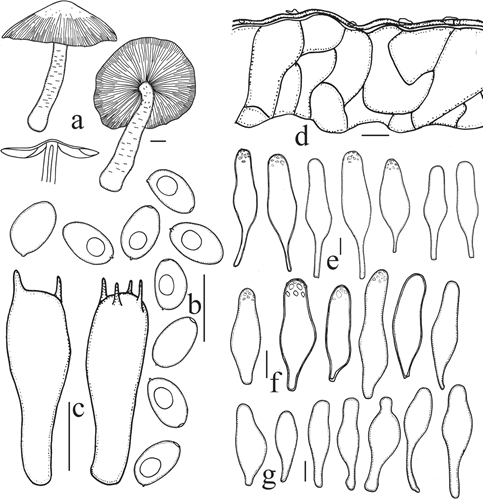Heteropsathyrella macrocystidia T. Bau & J.Q. Yan, sp. nov.
MycoBank number: MB 838373; Index Fungorum number: IF 838373; Facesoffungi number: FoF; Figs 2a–c, 3
Etymology. macrocystidia, referring to its large pleurocystidia, which are up to 83 μm long.
Type. China. Changbai Mountain, Antu County, Yanbian Korean Autonomous Prefecture, Jun-Qing Yan, Herbarium of Mycology, Jilin Agricultural University (HM-JAU37802).
Diagnosis. Differs from Psathyrella epimyces by saprophytic and abundant pseu- doparaphyses.
Pileus 35–70 mm broad, obtusely conic when young, expanding to plane, with a small obtuse umbo, hygrophanous, tawny to brown (7C6–7D7), darker at center (7E7), striate up to 2/3 from margin, becoming dirty white as pileus dries (7A1–7B2). Veil scattered, small, white (7A1), fibrillose, evanescent. Context hygrophanous, thin and fragile, approximately 1.0–1.5 mm at the centre. Lamellae 3.0–6.0 mm broad, crowded, adnexed, dirty white (7A1–7B2), becoming pale brown to brown (7E7–7F7) as spores mature, edge white (7A1) and even. Stipe 35–100 mm long, 5.0–15 mm thick, white (7A1), cylindrical, gradually thickening towards base, fragile, hollow, but context thick, surface uneven, with small grainy bulb, covered with small, white, evanescent fibrils. Odour and taste indistinctive. Spore print grey brown (7E3–7E4).
Spores 7.8–9.2 × 4.9–5.4 μm, Q = 1.6–1.8, elongated-ellipsoid in face view, in profile flattened on one side, pale brown in water, darker brown in 5% KOH, smooth, with or without 1–2 guttules, germ pore indistinct, approximately 1.0 μm in diam. Basidia 26–34 × 7.3–9.8 μm, clavate, hyaline, 4- or 2-spored. Pseudoparaphyses abundant and regular distribution. Pleurocystidia 59–83 × 12–20 μm, abundant, utriform with broadly obtuse apex, slightly thick-walled, glabrous or covered by irregular depos- its, base tapering to a long stipe. Cheilocystidia 37–56 × 9.8–17 μm, utriform to fusoid with obtuse apex, base tapering to a short stipe. Caulocystidia 29–61 × 12–22 μm, caespitose, various, utriform, fusoid or utriform with abrupt narrow neck terminating in a capitellum, base tapering to a long or short stipe. Trama of gills irregular. Pileipellis a 1–2-cell-deep layer of vesiculose cells, up to 61 μm long, covered by a 1-cell-deep layer of periclinal hyphae which are approximately 3.6 μm in diam and covered by scattered and irregular deposition dissolving in 5% KOH. Clamps present.
Habit and habitat. Scattered on mossy rotten wood in mixed forests of larch and birch.
Other specimens examined. China. Changbai Mountain, Antu County, Yanbian Korean Autonomous Prefecture, Jun-Qing Yan, 16 July 2016, HMJAU37803; 28 July 2017, HMJAU37912.

Figure 2. Basidiomata a–c Heteropsathyrella macrocystidia (HMJAU37802) d–f Psathyrella amygdalinospora (HMJAU37952) g, h P. piluliformoides (HMJAU37923) i P. truncatisporoides (HMJAU37947). Scale bars: 10 mm (a–i).

Figure 3. Heteropsathyrella macrocystidia (HMJAU37802) a basidiomata b basidiospores c basidia d pileipellis e pleurocystidia f cheilocystidia g caulocystidia. Scale bars: = 10 mm (a); 10 μm (b–g).
